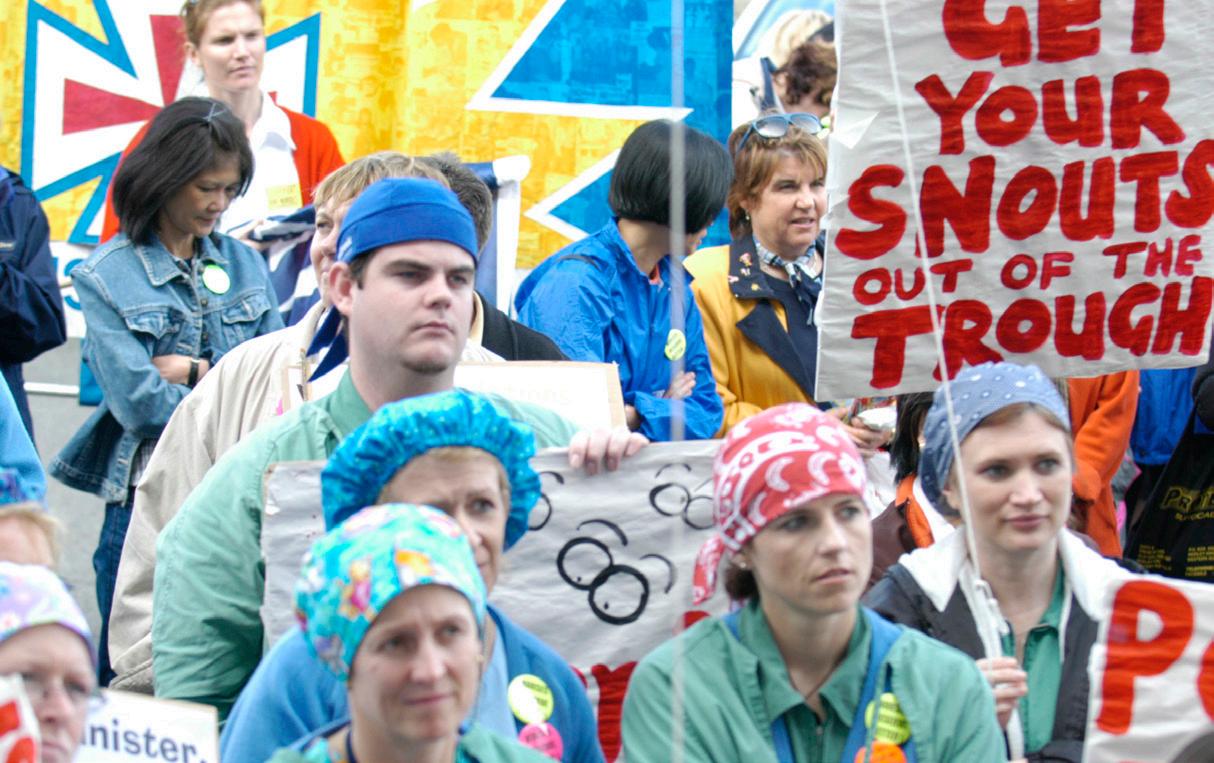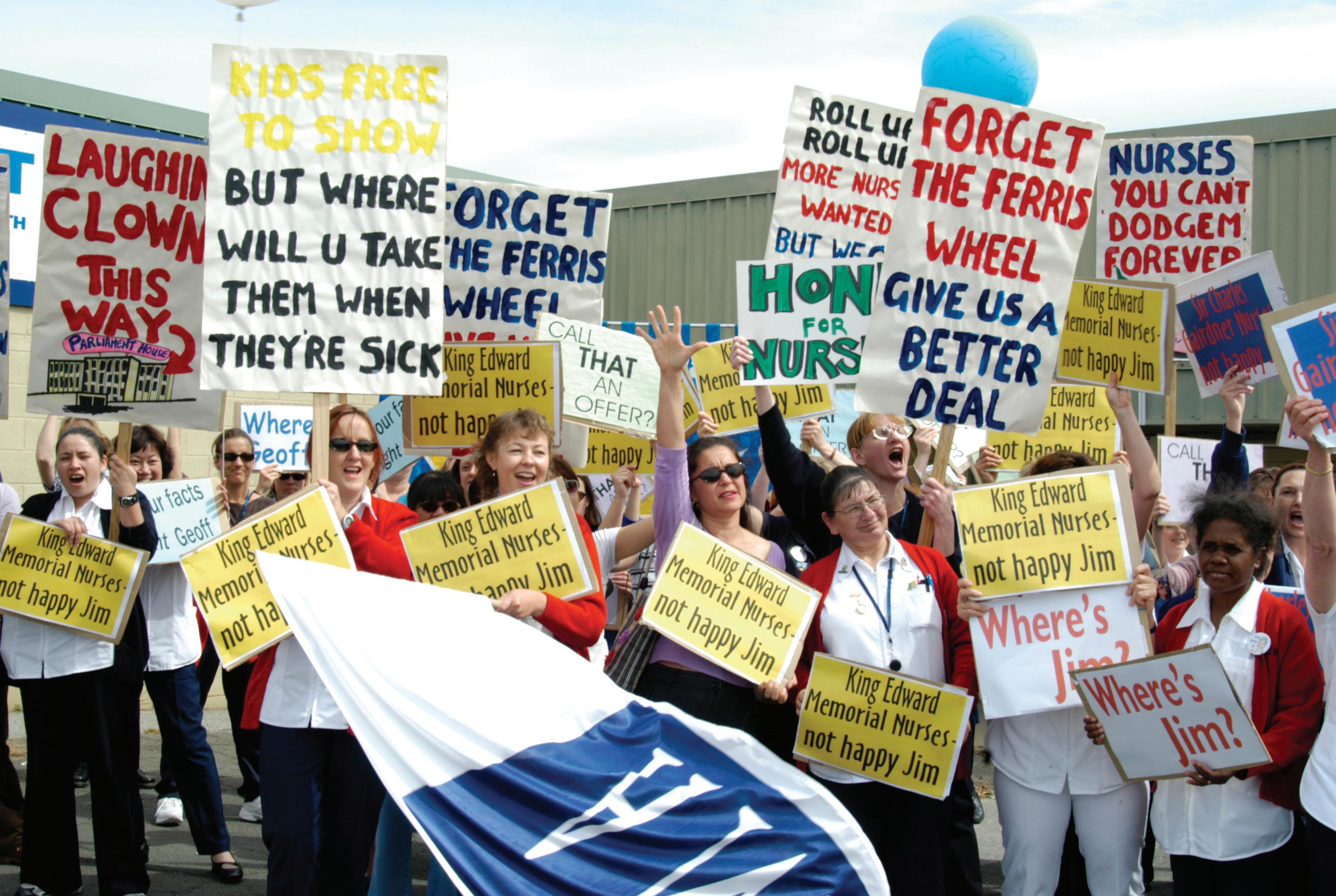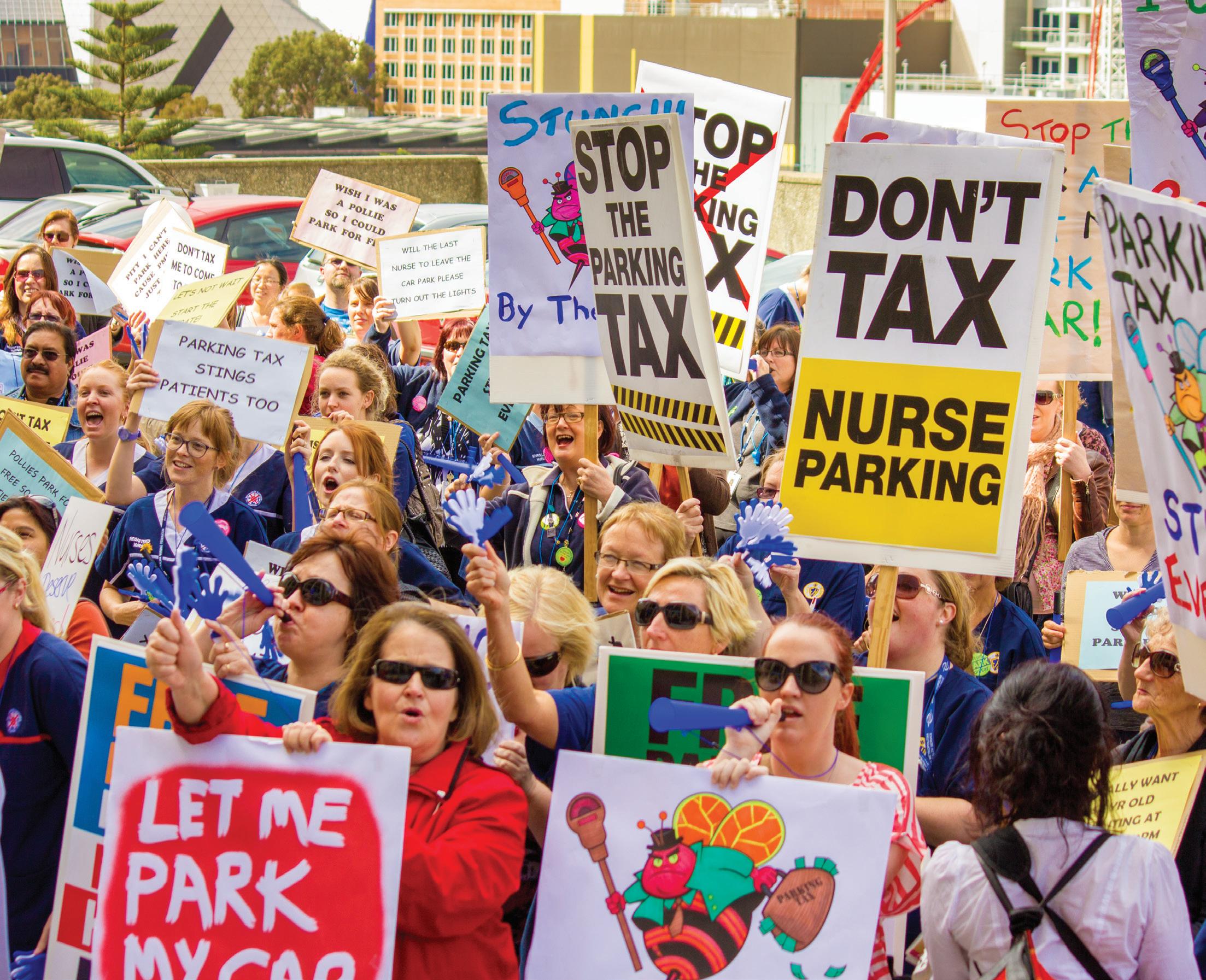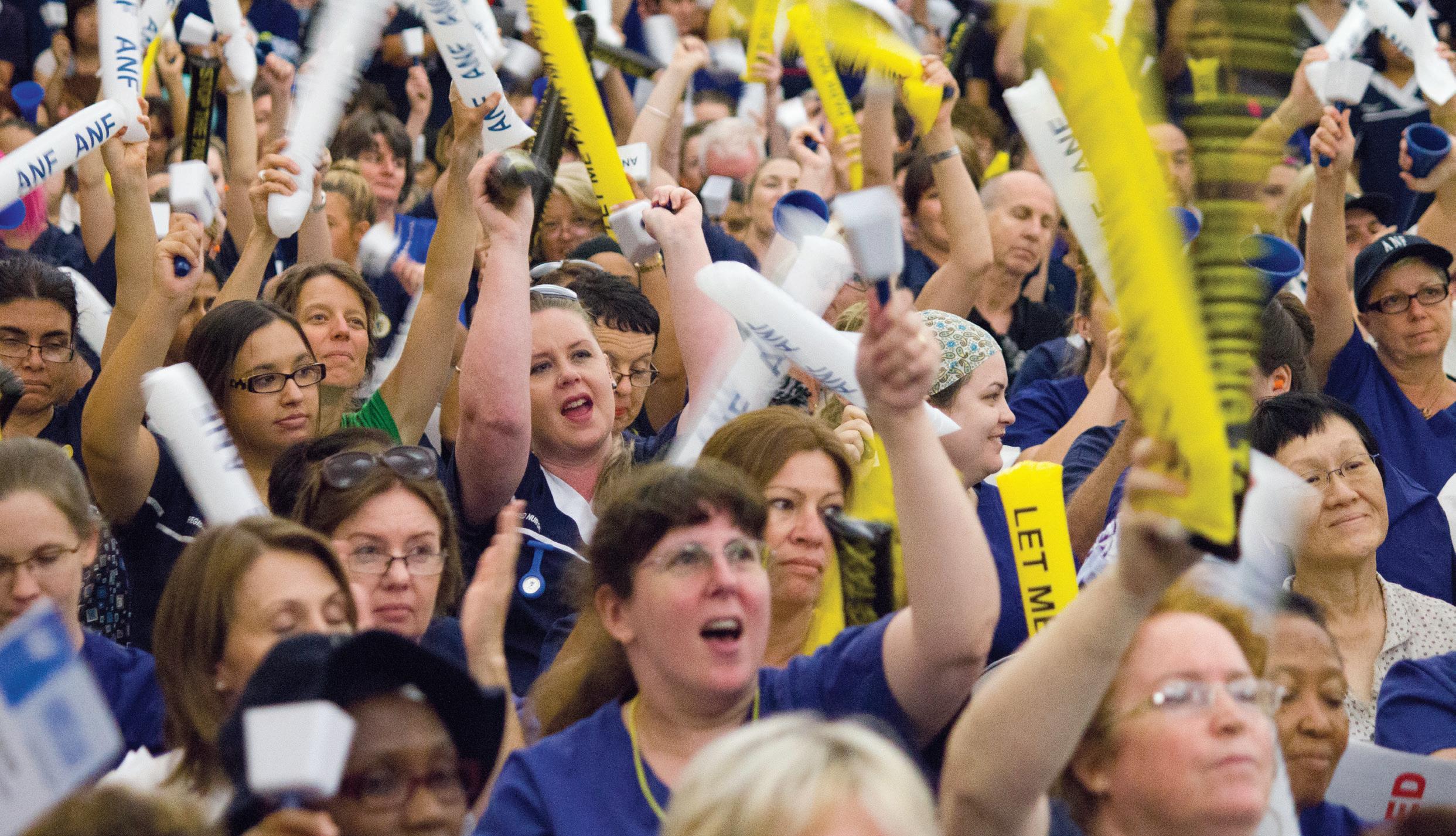1990’S THE LOST DECADE
The 1990s is largely remembered as the decade ANF members in the public and private sector lost a large number of conditions that drove many out of the industry and left the WA health system struggling to find nurses and midwives by the year 2000.

It was the decade where the term “trade off” was increasingly used by governments and private sector employers alike when responding to wage claims by ANF members. That is, they would say if you want a pay rise then you need to trade-off conditions to pay for it.
In November 1998, ANF members elected a new State Secretary who had a plan to recover these lost conditions in the new millennium with carefully structured media and industrial campaigns.
Some of the losses during this decade included:
1990 – Qualification allowance lost
1991 – Hourly on call rate lost
1991 – Senior Nurses excluded from overtime payments
1994 – RN’s and midwives lose automatic entitlement to 7 weeks annual leave with many members having their annual leave reduced by up to three weeks with the creation of the new category of “continuous shift worker” and the exclusion or many part time staff from pro-rata leave
1994 – Public Holidays – if you were part time and not a continuous shift worker, then you were not entitled to any public holiday leave unless you actually worked the public holiday
1992 to 1998 – ADOs for full time staff was lost at various at various public hospitals throughout the decade as hospitals moved to introduce shorter shifts where 70 hours worked over 10 days became the new normal for nurses entering the workforce particularly graduates. And in private hospitals they were lost altogether
1998 – ADOs lost for all part timers – and when the part time staff lost their ADOs many also lost 5% of their working hours
1998 – RN’s and Midwives lose penalties on sick leave
1998 as the nursing shortage starts to bite, public hospitals decide pay out public holidays rather than allowing nurses to take them as leave
Paid Maternity leave did not exist throughout the entire 1990s
Rural gratuities did not exist throughout the entire 1990s
Nursing career structure decimated with Clinical Nurses, Clinical Midwives, Nursing and Midwifery Educators significantly reduced in numbers.
Next up… the 20 year recovery… SPECIAL LIFT OUT June-July 2022 western nurse | 17
A NEW millennium brings recovery

ANF State Secretary Mark Olson says the key feature of negotiations from the year 2000 onwards has been the recovery of lost conditions, the gains of conditions that did not exist previously, never giving up on claims no matter how long it takes to get there and a constant battle to keep the wages of nurses and midwives better than those in other states.

The public sector EBA negotiations are not only important for those ANF members working in the public sector, they set the pay and conditions benchmarks for the private sector as well. Mark also says that negotiations never really stop with the signing of each new wage agreement.
“Actions by governments between each EBA and other events means the ANF is constantly listening to members to establish the priorities for the upcoming EBA. We also use the time to bring matters to the attention of the media so that the public has some understanding of the issues faced by our members which is critical to retaining public support when holding stop work meetings or closing beds.”
 ANF Members on the march in Bunbury 2001
ANF Members on the march in Bunbury 2001
18 | western nurse June-July 2022
Bed closure vote at Fremantle Hospital – February 2001
2000/2001

This campaign started in September 2000 and had two distinct phases. The first part was in the lead up to the 2001 state election where ANF members closed one-in-four hospital beds that helped to secure a minimum increase of 13.5% with further improvements to be negotiated after the election. Unfortunately, the incoming Labor Government continued to resist the other claims of ANF members and a second campaign was conducted by the ANF from February till June 2001 that achieved even higher wage increases and a suite of other recovered conditions.
2002
Workloads case run by ANF in Federal Industrial Commission
In the year following the 2001 EBA negotiation the ANF also conducted an Exceptional Matters Case in the Federal Industrial Commission where we successfully argued for nurses & midwives to have their workloads regulated with a benchmark minimum hours in accordance with the Nursing Hours Per Patient per Day model. This resulted in an initial increase of 400 extra nurses.
FINAL OUTCOME 2001:
• Public sector nurses brought back into the one agreement thereby ensuring that country public sector nurses would never again lag behind their colleagues working in Perth

• 18% wage increase over three years including 2 additional increments for Level 1 with flow on to Level 2 giving them a 17.1%. SRN positions were created giving them a further increase of 6% to 12% in 2002
• Night shift rate increased to 20%
• Return of hourly on call rate
• All nurses who had been employed on 70 hours (10x7 hour shifts) offered full time hours + ADO’s
• All staff entitled to 10 days Public Holiday leave & pro rata for part time staff
• Paid parental leave for the first time – 6 weeks
• Permanent night staff included in definition of continuous shift worker
• Professional Development leave introduced – 2 day for metro and 4 days for rural
• Qualification allowance - one off payment
• Various rural gratuity payments to assist recruitment in difficult to staff areas.
June-July 2022 western nurse | 19
Rally at Challenge Stadium, May 2001
2004/2005
This campaign was probably the most bitter, longest and hardest fought of all campaigns and lasted over a year during which nurses continued their campaign through a federal election in October 2004 as well as a state election in 2005. At one point the Labor government even put pressure on ANF members to vote for a NON Union agreement but it was rejected. Whilst there were no bed closures, there were plenty of hospital based stop work meetings, lots of ANF media stunts particularly in the lead up to the 2005 state election and lots of legal maneuverings by the government to undermine the ANF campaign and force ANF members to accept the lower pay increases already agreed to by other public sector unions.


FINAL OUTCOME 2005:
• 14.7% wage increase over three years
• Night shift loading on Sunday night extended to 7.30am Monday morning
• Shift coordination allowance for level 1 nurses.
2007/2008
As the state Labor government approached the 2008 state election, it was apparent early in negotiations by the reasonable responses to the ANF claims that they were keen to avoid a repeat of the bitter and protracted 2004 dispute. It was an opportunity for the ANF to secure some long sought after initiatives and showed that it is not always necessary to take industrial action to achieve an outcome - so long as the government has, in the back of their mind, the knowledge that a public ANF industrial and media campaign can be started at any time.
 ANF members rallied everywhere. Members from KEMH and SCGH gather at a rally outside the Royal Show in September 2004
ANF members rallied everywhere. Members from KEMH and SCGH gather at a rally outside the Royal Show in September 2004
20 | western nurse June-July 2022
ANF members rally at Parliament House – 2012
FINAL OUTCOME 2008:
• Wage increase 17% for Level 1, 14.1% for all other categories
• Qualification allowance finally restored as a weekly allowance + ANF gets independent review panel
• Night shift increased from 20% to 35%
• Evening shift increased from 12.5% to 15%
• Parental leave increased from 6 weeks to 14 weeks.
2010
The focus of this campaign was parking access and charges, rural gratuities tied to royalties for regions and additional sick leave. There
were the usual number of workplace meetings held and public awareness campaign but no industrial action. The government did try its best through the industrial commission to take a few conditions away from nurses and deny our country members access to the rural gratuities but they were unequivocally rebuffed by the ANF.

FINAL OUTCOME 2010:
• 12.75% over three years

• Major increases in rural gratuity payments
• Sick leave days increased from 10 to 15
• ANF Qualifications list extended
• ANF and/or members able to request a review of the NHPpD for their ward or unit for increased staffing.
June-July 2022 western nurse | 21
ANF members rally outside Parliament House 2012
2013
The “shake the tree” campaign

This was the first campaign where everyone knew the date of the WA state election as it had been fixed in legislation to be forever held in early March. The public sector agreement did not expire until July 2013 but the ANF was keen to lock in a wage increase before the election because we knew the government was looking to force the ANF to trade-off conditions for a pay rise once the pressure of an election had passed and the government had secured another 4 year term.
In the previous few years nurses and midwives had dropped down the national rankings compared to the other states while teachers, police and allied health workers climbed to the top of their respective interstate comparisons. So the focus of the campaign became getting the wages of nurses and midwives back to the highest in Australia (which we did) and to pick up a few more improvements in conditions along the way.
The ANF campaign started with a rally at parliament house in September 2012 followed by ongoing work by the ANF in the media as well as many hospitals based meetings held across the state.
The pointy end of the campaign came soon after the government launched its official state election campaign and three weeks out from polling day, ANF members met at the WA Italia Club and voted to close one in every five beds. The ANF also unleashed the two, seven foot high ANF Bee mascots who proceeded to disrupt just about every press conference held by the Premier, Colin Barnett and then Treasurer Troy Buswell. This was in addition to an extensive paid advertising blitz in print and on radio.
A key feature of this campaign was the improvements in ANF communications that enabled the ANF to protect our members from the various legal threats that were made at the time to those closing beds that included dismissal as well as deregistration.
After a week of closing beds in addition mounting pressure in the media, and despite the various legal threats and challenges to the ANF the government agreed to a 14.7% wage increase and for all other outstanding ANF claims to be decided by arbitration after the election with a guarantee of no lost conditions.
FINAL OUTCOME 2013: • 14.7% wages increase over three years with a range of matters to be dealt with in formal hearings at the WA Industrial Commission (WAIRC)
 ANF members at the Italian club in February 2013 voting to close 1 in 5 beds
ANF members at the Italian club in February 2013 voting to close 1 in 5 beds
22 | western nurse June-July 2022
2014/2015

ANF pursues further matters in the WAIRC
The ANF Legal and Industrial Team spent a large part of 2013 and 2014 preparing then presenting our case for further improvements in conditions for our members. The hearings dragged on into 2015 as the government lodged appeals against the favourable outcomes form ANF and in the end the appeals were rejected and more conditions were improved.

FINAL OUTCOME 2015:
• Return of ADOs for part time staff lost in 1998
• Allowance for authorised mental health practitioners
• Higher duties paid on shift by shift basis
• Lead Apron allowance
• Overtime rates for casuals
• Pro rata long service leave after 7 years
• Better access to purchased leave
• Parking charges capped at CPI.
2016
This was probably the most uneventful wage negotiation ever as members accepted government wages policy of 1.5% per year for two years because it kept them as the highest paid nurses and midwives until at least 2017.

FINAL OUTCOME 2016:
• 3 % increase over two years
What a difference a decade makes - Mark McGowan supporting the nurses pay claim at Parliament House rally in 2012 and even wearing an ANF badge, in front of the ANF Banner… when he was Opposition Leader!
June-July 2022 western nurse | 23
ANF members at the start of the “Shake the tree” campaign.
2018
Not long after coming to office in 2017 the McGowan Government announced a new wages policy (that is, one they did not tell the public about prior to the election) limiting wage increases to $1,000 per year for all public sector employees. The government also made it clear that if any public sector union challenged the government $1,000 wages cap with any type of industrial action, the government would not hesitate to take matters to the WA Industrial Commission where losing conditions would become a likely outcome. As a result all public sector unions accepted the government wages cap of $1,000 per year for four years.
In this context the ANF focused on low-cost and no-cost initiatives in the 2018 negotiations as well as additional staffing in 2020 negotiations.
Prior to the 2018 negotiations the Health Dept had secretly removed a range of midwifery qualifications from the official list. These were eventually restored after a campaign by the ANF. However, this action by the Health Dept led to an insistence by the ANF that all qualifications attracting an allowance be listed in the EBA so they could never again be unilaterally deleted by the government.
FINAL OUTCOME 2018:
• $1,000 yearly pay increase
• Cashing out leave more accessible
• Better access to leave entitlements.
• Mandatory online training to be completed during work time
• Night shift staff protected from arbitrary day rotations, they are not a requirement of employment but where it does occur, there has to be an education plan and it’s for a maximum of 2 weeks each year
• Qualifications cannot be removed from the approved qualification allowance list.
FINAL OUTCOME 2018:
• Wage increase of $1,000 each year for two years
• Professional development leave that is not used to be paid out each year in July
• Casual loading increased from 20% to 25% + casuals get access to Long Service Leave

• Better access to purchased leave, deferred salary scheme and long service leave
• Recognition by the Health Minister that the existing NHpPD formula can be converted to a transparent minimum number of nurses per shift which will form the benchmark for the review undertaken by Professor Della
• 400 extra nurses – over two years.
2020 and 2021 – Ongoing
Campaign for more staff resulted in the government doubling the intake of graduates and increasing numbers in various wards and units.
Next time we shake the tree is in 2022.
24 | western nurse June-July 2022




 ANF Members on the march in Bunbury 2001
ANF Members on the march in Bunbury 2001





 ANF members at the Italian club in February 2013 voting to close 1 in 5 beds
ANF members at the Italian club in February 2013 voting to close 1 in 5 beds

